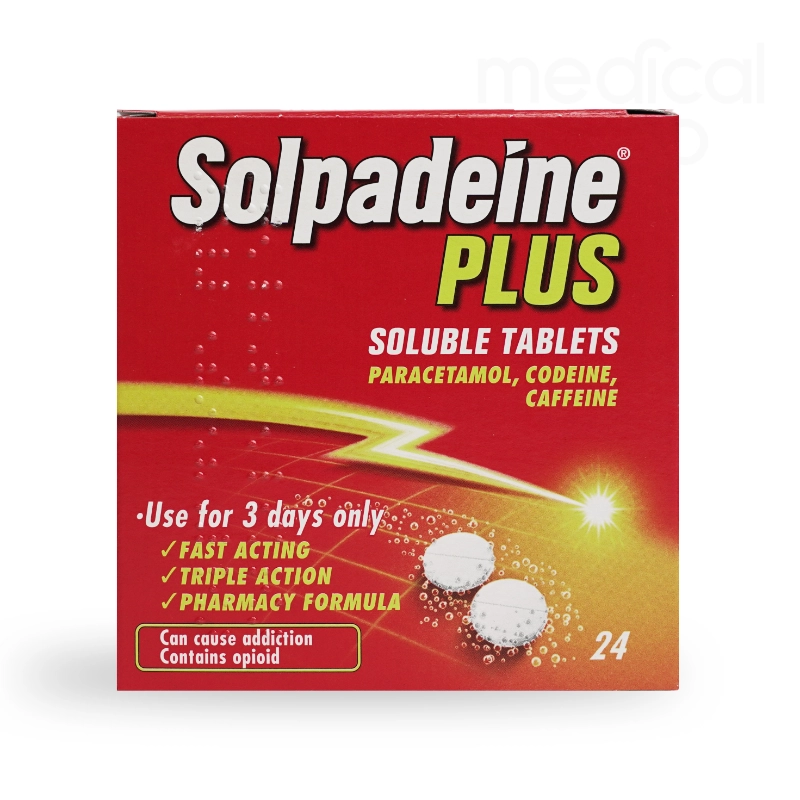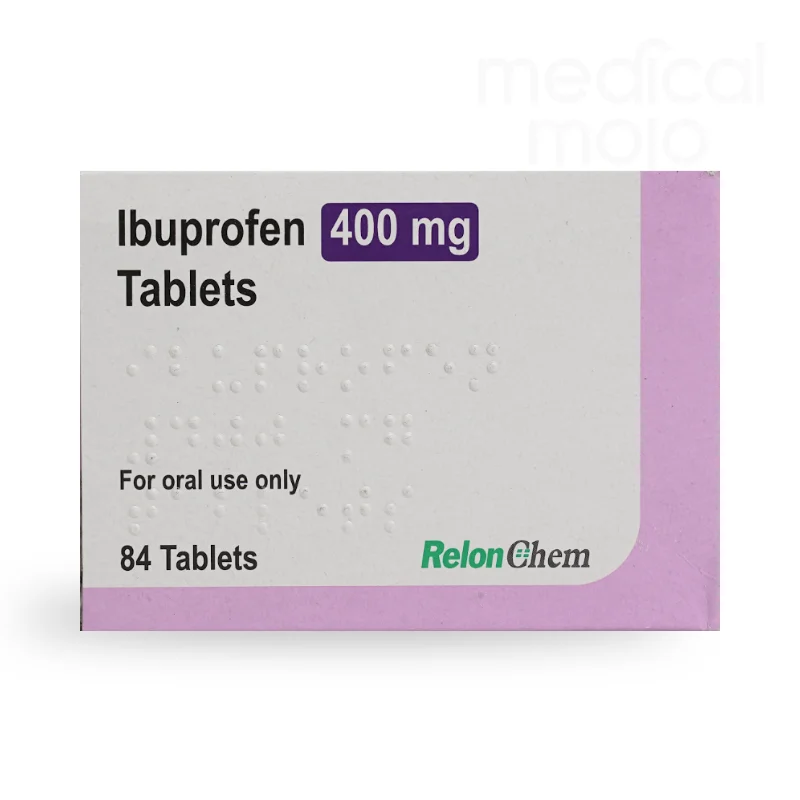Pain relief
Take the edge off your pain with our range of prescription and over the counter pain killers
Soluble tablets for fast pain relief action.
Need help dealing with pain, talk to our one to one wellness coaches for advice.
Find the right pain relief treatment for you
View All ProductsWhat you should know about pain?
Acute pain is short-term pain that typically occurs suddenly and is usually linked to a specific injury or illness. It usually subsides once the underlying cause is treated. Chronic pain, on the other hand, lasts for weeks, months, or even years, and may continue even after the injury or illness has healed. Chronic pain often requires a comprehensive pain management plan.
Yes, you can take ibuprofen and paracetamol together as they work in different ways to relieve pain. Paracetamol is generally used to reduce fever and relieve mild to moderate pain, while ibuprofen is an anti-inflammatory that also helps with pain and swelling. However, it’s important to follow the recommended dosages and consult with a healthcare provider if you have any concerns.
Paracetamol is generally considered safe to take during pregnancy when used as directed and at the lowest effective dose for the shortest possible time. However, it’s always best to consult with your doctor or midwife before taking any medication during pregnancy.
Yes, codeine can be addictive. It is an opioid painkiller, and prolonged use or misuse can lead to physical dependence and addiction. It’s important to take codeine only as prescribed by a healthcare professional and to follow the dosage instructions carefully.
Common side effects of NSAIDs like ibuprofen include stomach pain, heartburn, nausea, and, in some cases, increased risk of stomach ulcers or bleeding. Long-term use can also affect kidney function and increase the risk of cardiovascular problems. Always take NSAIDs as directed and consult your healthcare provider if you have any pre-existing conditions.
Physical therapy involves exercises and treatments designed to improve mobility, strengthen muscles, and alleviate pain. It is often used for chronic pain conditions like back pain, arthritis, and after injuries. Physical therapy can help reduce the need for pain medications and improve overall function and quality of life.
Yes, there are several non-medication options for pain relief, including physical therapy, acupuncture, massage therapy, cognitive behavioral therapy (CBT), and lifestyle changes such as exercise and a healthy diet. These approaches can be effective, either on their own or in combination with medications, depending on the type and severity of the pain.
Anticonvulsants are primarily used to treat epilepsy but can also be effective in managing certain types of chronic pain, particularly neuropathic pain (pain caused by nerve damage). They work by stabilizing electrical activity in the nervous system and reducing pain signals. Common anticonvulsants used for pain relief include gabapentin and pregabalin. These medications can have side effects like drowsiness, dizziness, and weight gain.
Additional information
What is pain, and what causes it?
Pain is the body’s way of telling you that someone is wrong. By its very nature, pain is something that you can’t ignore, so in that sense, it is actually a good, although unpleasant, alarm system. What would happen if we could not feel pain? Imagine the situation if your hand was in a fire. If you could feel no pain, you would not immediately jerk your hand away; rather, your hand would remain there. Pain gives you the instant stimulus to withdraw your hand before any significant damage is done. All of us have and will continue to experience pain, our nervous system will continue to trigger this unpleasant sensation in response to injury, illness, or stress. It can manifest as a sharp, acute jolt or a dull, persistent ache.
Pain can be localised to one area, like a throbbing headache, or it can be widespread, as with muscle aches during the flu. Pain serves a vital purpose: it alerts you to potential harm, prompting you to take action or seek treatment. Once the underlying cause is treated, pain typically subsides, which is classified as acute pain. However, when pain persists for weeks, months, or even years, it is considered chronic pain, often associated with long-term conditions like arthritis or fibromyalgia.
What are the symptoms of pain?
Pain can vary greatly in its presentation and intensity, but common symptoms include:
- Sharp, stabbing pain: Often associated with injuries or acute conditions.
- Dull, aching pain: Typically linked to chronic conditions like arthritis.
- Burning or tingling sensations: Common with nerve-related pain.
- Throbbing or pulsing pain: Frequently seen in headaches or migraines.
- Stiffness: Especially in joints or muscles, limiting movement.
- Fatigue: Chronic pain can lead to constant tiredness or lethargy.
These symptoms can help guide the choice of treatment and the need for medical consultation.
Types of pain
OK, it’s time to get a bit technical. Let’s look out how the boffins describe pain, by doing this we can understand our pain better which will allow us to make better decisions regarding our treatment options.
Pain can be further categorized into several types: nociceptive, non-nociceptive, somatic, neuropathic, sympathetic, visceral, and referred.
Nociceptive pain arises when specific pain receptors are activated. These receptors detect sensations such as vibrations, temperature changes, inflammation, stretching, and the chemicals released by damaged cells.
Non-nociceptive pain isn’t triggered by these pain receptors. Instead, it results from nerves that have become damaged or unstable, leading to confused signalling. The brain interprets these abnormal signals as pain, even in the absence of typical pain stimuli.
Somatic pain is a subset of nociceptive pain, typically felt in the skin, muscles, joints, ligaments, and bones. This type of pain is often sharp and localised to the area of injury or inflammation.
Neuropathic pain is a type of non-nociceptive pain that originates within the nervous system itself. Often described as a “trapped” or “pinched” nerve, this pain stems from issues within the peripheral or central nervous systems. Causes include nerve degeneration, inflammation, pressure on the nerves, or nerve infections.
Sympathetic pain (another form of non-nociceptive pain) involves the sympathetic nervous system, which controls functions like blood flow and perspiration. This pain often follows bone fractures or soft tissue injuries. Similar to neuropathic pain, it occurs when a nerve is damaged or unstable, sending incorrect pain signals to the brain.
Visceral pain is a type of nociceptive pain experienced in the internal organs and major body cavities, such as the chest, abdomen, and pelvis. Unlike somatic pain, visceral pain is harder to pinpoint, often presenting as a deep ache or cramping sensation. This type of pain is often associated with back pain: thoracic (upper back), abdominal (mid-back), and pelvic (lower back).
Referred pain, sometimes called reflective pain, is felt in areas distant from the actual site of injury or illness. For instance, during a heart attack, a person might feel pain in the shoulders, back, or neck rather than in the chest. The exact mechanisms behind referred pain are not yet fully understood.
Common causes of pain and their appropriate treatments
Pain is a complex experience that can arise from various conditions and injuries, affecting different parts of the body. Understanding the common causes of pain and the most appropriate treatments for each can help manage discomfort effectively and improve overall quality of life.
What causes pain?
Pain arises from various triggers, each affecting the body differently:
- Injuries: Physical trauma such as sprains, fractures, or burns.
- Chronic conditions: Long-term ailments like arthritis, migraines, or fibromyalgia.
- Inflammation: Often related to conditions like bursitis or tendonitis.
- Nerve damage: Neuropathic pain from nerve compression or damage, such as sciatica.
- Infections: Pain as a symptom of bacterial or viral infections.
- Muscle strain: Overuse or improper movement causing muscle tension.
Identifying the root cause of pain is crucial for effective treatment and management.
Below are some of the most frequent causes of pain and the recommended treatments for each.
1. Back pain
Most cases of back pain are not caused by anything severe and are often due to minor sprains or injuries. These injuries can occur from awkward bending or twisting, lifting heavy objects improperly, overstretching, poor posture (like slouching or hunching), and overusing muscles. However, back pain can sometimes be a symptom of a more serious medical condition, such as sciatica, arthritis, or a slipped or prolapsed disc. In rare instances, back pain may indicate a more critical issue, such as a spinal fracture, infection, or even cancer.
Treatment:
- Over-the-counter pain relievers (e.g., ibuprofen or paracetamol).
- Physical therapy and exercises to strengthen the back muscles.
- Heat or cold therapy to reduce inflammation and ease discomfort.
- Proper ergonomics and posture correction.
- In severe cases, prescription medications or surgical interventions may be necessary.
2. Headaches
Headaches can be broadly categorized into two types: primary and secondary. Primary headaches are usually caused by a dysfunction or overactivity of pain-sensitive structures in the head. Common examples include migraines, tension headaches, and cluster headaches. On the other hand, secondary headaches are a symptom of an underlying condition that stimulates the pain-sensitive nerves in the head, such as sinus infections, high blood pressure, or even a hangover from alcohol consumption.
Treatment:
- Over-the-counter pain relievers (e.g., ibuprofen, aspirin, paracetamol).
- Prescription medications for migraines (e.g., triptans).
- Relaxation techniques, stress management, and adequate hydration.
- Addressing underlying causes for secondary headaches, such as sinus infections or hypertension.
3. Joint pain
Joint pain typically arises from damage to the joints, whether through disease or injury. A wide range of conditions can lead to joint pain, including osteoarthritis, rheumatoid arthritis, gout, bursitis, sprains, and strains. The pain may be localised to a specific joint, such as the knees, hips, or shoulders, and can vary in intensity from mild discomfort to severe, debilitating pain.
Treatment:
- Nonsteroidal anti-inflammatory drugs (NSAIDs) for pain and inflammation.
- Physical therapy to improve joint mobility and strength.
- Corticosteroid injections for severe inflammation.
- Disease-modifying antirheumatic drugs (DMARDs) for rheumatoid arthritis.
- Weight management and regular exercise to reduce joint stress.
4. Period pain (dysmenorrhea)
Period pain occurs due to the muscular contractions of the uterus. While these contractions typically happen throughout the menstrual cycle and are so mild that they often go unnoticed, they can become more intense during menstruation. This increase in intensity helps the uterus shed its lining as part of the monthly cycle. These stronger contractions can temporarily compress the blood vessels within the uterus, reducing the blood flow and causing the surrounding tissues to become deprived of oxygen. As a result, the tissues release chemicals called prostaglandins, which are responsible for triggering pain and inflammation.
Nonsteroidal anti-inflammatory drugs (NSAIDs) can be effective in managing period pain because they work by inhibiting the enzyme cyclooxygenase (COX), which is involved in the production of prostaglandins. By reducing the formation of prostaglandins, NSAIDs help to alleviate the intensity of uterine contractions and the associated pain and discomfort.
Treatment:
- Over-the-counter pain relievers (e.g., ibuprofen or naproxen).
- Heat therapy (e.g., heating pads or warm baths).
- Hormonal birth control methods to reduce the severity of menstrual cramps.
- Lifestyle changes, such as regular exercise and stress management.
5. Muscle pain (myalgia)
Muscle pain, or myalgia, is often caused by stress, tension, or physical overexertion. However, it can also be related to various medical conditions, including viral or bacterial infections, fibromyalgia, thyroid disorders, low potassium levels (hypokalaemia), autoimmune diseases, and certain medications, such as ACE inhibitors.
Treatment:
- Rest and over-the-counter pain relievers (e.g., paracetamol, ibuprofen).
- Gentle stretching and physical therapy.
- Addressing underlying medical conditions (e.g., thyroid treatment, electrolyte balance).
- Warm baths or massages to relax tense muscles.
- Adjustments to medication if drug-induced.
6. Dental pain
Toothache is usually the result of inflammation in the tooth’s innermost layer, known as the dental pulp. The dental pulp contains sensitive nerves and blood vessels, and when it becomes inflamed due to tooth decay, receding gums, a cracked tooth, or an abscess, it can cause significant pain. Other conditions, such as swollen gums, sinusitis, ulcers, or injury to the temporomandibular joint (TMJ), can also lead to dental pain.
Treatment:
- Over-the-counter pain relievers and anti-inflammatories.
- Proper oral hygiene practices, including brushing, flossing, and using mouthwash.
- Dental treatments such as fillings, root canals, or extractions.
- Addressing underlying conditions like sinusitis or TMJ disorders.
- For teething in babies, teething gels and gentle gum massages may provide relief.
Nerve pain, also known as neuropathy, occurs when there is damage or dysfunction in the nerves, causing them to send incorrect signals to the brain. This type of pain is often described as burning, tingling, or shooting and can be a result of conditions like diabetes, shingles, or nerve compression. Neuropathic pain can be particularly challenging to manage because it doesn’t always respond well to standard pain relievers.
Treatment:
- Medications: Prescription medications such as anticonvulsants (e.g., gabapentin, pregabalin) and antidepressants (e.g., amitriptyline) are commonly used to manage nerve pain.
- Topical treatments: Creams or patches containing lidocaine or capsaicin can be applied to the affected area to reduce pain.
- Physical therapy: Strengthening exercises and techniques to improve mobility and reduce nerve compression.
- Nerve blocks: In some cases, a healthcare provider may administer nerve blocks to provide temporary relief from severe pain.
- Lifestyle adjustments: Managing underlying conditions, such as diabetes, is crucial to prevent further nerve damage.
8. Cancer pain
Pain associated with cancer can arise from the tumour itself pressing on bones, nerves, or other organs or from the treatment used to combat cancer, such as chemotherapy, radiation, or surgery. Cancer pain can be acute, chronic, or breakthrough pain, which is a sudden flare-up of pain that occurs even when pain medication is being used.
Treatment:
- Medications: A combination of medications may be used, including non-opioid pain relievers, opioid analgesics, and adjuvant medications such as antidepressants or anticonvulsants.
- Radiation therapy: In cases where a tumour is causing pain, radiation therapy may be used to shrink the tumour and relieve discomfort.
- Nerve blocks: Injection of an anaesthetic into or around nerves to block pain signals.
- Physical therapy: Helps to strengthen the body and improve mobility, potentially reducing pain.
- Psychological support: Counseling and cognitive-behavioral therapy (CBT) can be beneficial in managing the emotional and psychological aspects of chronic cancer pain.
Fibromyalgia is a chronic condition characterized by widespread musculoskeletal pain, often accompanied by fatigue, sleep disturbances, and cognitive issues such as memory problems or “fibro fog.” The exact cause of fibromyalgia remains unclear, but it is believed to involve a combination of genetic, environmental, and psychological factors that lead to heightened sensitivity to pain signals.
Treatment:
- Medications:
- Pain relievers: Over-the-counter options like acetaminophen and NSAIDs can help manage mild pain, while prescription medications may be necessary for more severe pain.
- Antidepressants: Medications such as amitriptyline and duloxetine can help reduce pain and improve sleep quality by balancing neurotransmitters in the brain.
- Anticonvulsants: Drugs like pregabalin (Lyrica) and gabapentin (Neurontin) are commonly prescribed to reduce nerve sensitivity and alleviate pain.
- Low-Dose Naltrexone (LDN): An emerging treatment for fibromyalgia, low-dose naltrexone (LDN) is an opioid antagonist that, when taken in low doses, is believed to reduce inflammation and modulate the immune system. LDN has shown promise in reducing pain and improving quality of life in some fibromyalgia patients, although more research is needed to fully understand its effectiveness.
- Physical therapy: Regular exercise, including aerobic activities and strength training, can help alleviate pain and improve overall physical function. Stretching exercises and gentle yoga may also be beneficial in enhancing flexibility and reducing stiffness.
- Cognitive Behavioral Therapy (CBT): CBT helps patients manage the psychological aspects of chronic pain, including stress and anxiety, which can exacerbate fibromyalgia symptoms. This therapy can also aid in developing coping strategies and improving sleep hygiene.
- Lifestyle adjustments:
- Stress management: Techniques such as mindfulness, meditation, and deep breathing exercises can help reduce the stress that often triggers or worsens fibromyalgia symptoms.
- Healthy diet: Maintaining a balanced diet rich in fruits, vegetables, and whole grains can support overall health and well-being, which is essential for managing fibromyalgia.
- Sleep hygiene: Establishing a regular sleep schedule, creating a restful sleep environment, and avoiding stimulants like caffeine before bedtime can improve sleep quality and reduce fatigue.
Fibromyalgia is a complex condition that requires a multifaceted treatment approach. By combining medications, lifestyle changes, and therapeutic interventions, many patients can manage their symptoms and improve their quality of life. The addition of low-dose naltrexone as a treatment option offers hope for those who have not found relief with more traditional therapies, but it should be used under the guidance of a healthcare provider.
Summary
Pain can manifest in various forms, from common back and joint pain to more complex conditions like nerve pain, cancer pain, and fibromyalgia. The treatment of pain requires a comprehensive approach that often involves medication, physical therapy, lifestyle adjustments, and sometimes psychological support. Understanding the specific cause of your pain is crucial in selecting the most effective treatment options. If your pain persists or worsens despite treatment, it’s important to consult with a healthcare professional to explore additional therapies and interventions.
By addressing the root causes and employing a multifaceted treatment plan, it’s possible to manage pain effectively and improve your quality of life.
Pain relief treatments
When it comes to managing pain, several types of medications are available, each working differently and suited to various types of pain. Here’s a breakdown of the main categories of pain relief treatments, how they work, the types of pain they are used for, and their potential side effects.
Opioids
How They Work: Opioids are powerful pain-relieving medications that work by binding to specific receptors in the brain and spinal cord, known as opioid receptors. This action reduces the transmission of pain signals to the brain, thereby lessening the sensation of pain.
Types of Pain: Opioids are typically used for moderate to severe pain, particularly when other pain relief methods are ineffective. They are commonly prescribed after surgery, for severe injury, and for pain associated with cancer or chronic conditions.
Examples:
- Morphine: Often used in hospital settings for severe pain.
- Oxycodone: Commonly prescribed for both acute and chronic pain.
- Fentanyl: A potent opioid often used in patches for chronic pain management.
- Codeine: Used for mild to moderate pain, often combined with other painkillers like paracetamol.
Side Effects:
- Nausea and vomiting
- Drowsiness and sedation
- Constipation
- Respiratory depression (in high doses)
- Risk of addiction and dependence
Who Should Not Take Them: Opioids should be used with caution in individuals with a history of substance abuse, respiratory conditions like asthma, or those with liver or kidney problems. Pregnant or breastfeeding women should avoid opioids unless specifically advised by a healthcare provider.
Paracetamol
How it works:
It’s hard to believe that even though it is one of the most widely drugs, we still don’t know the precise mechanism of action for paracetamol. We know it’s an effetive pain killer so we left it that for many years, but researchers have come up with the following theories as to how it produces it’s analgesia.
- Inhibition of Prostaglandin Synthesis: Paracetamol is thought to inhibit the synthesis of prostaglandins in the brain, particularly in the hypothalamus, which helps reduce fever and alleviate pain. Unlike nonsteroidal anti-inflammatory drugs (NSAIDs), which inhibit cyclooxygenase (COX) enzymes throughout the body, paracetamol appears to selectively inhibit a variant of the COX enzyme in the central nervous system. This selective inhibition might explain why paracetamol has pain-relieving and fever-reducing effects without the anti-inflammatory properties typically seen with NSAIDs.
- Interaction with Serotonergic Pathways: Another theory suggests that paracetamol may enhance the effects of serotonergic pathways in the central nervous system, which could contribute to its analgesic effects.
- Endocannabinoid System: Some research suggests that paracetamol’s metabolites might interact with the endocannabinoid system, potentially contributing to its pain-relieving effects.
In summary, while paracetamol is effective as a pain reliever and fever reducer, the exact mechanisms by which it works are still not completely understood, and it likely involves multiple pathways in the central nervous system.
Types of Pain: Paracetamol is generally used for mild to moderate pain, such as headaches, muscle aches, toothache, and fever.
Examples:
- Panadol
- Tylenol
- Anadin Paracetamol
Side Effects:
- Generally well-tolerated
- Rarely, it can cause liver damage, particularly in high doses or with chronic use.
- Allergic reactions, although rare
Who Should Not Take Them: Individuals with liver disease or those who consume alcohol regularly should use paracetamol with caution due to the increased risk of liver toxicity. It’s also essential not to exceed the recommended dosage.
Nonsteroidal Anti-Inflammatory Drugs (NSAIDs)
How They Work: NSAIDs work by inhibiting the cyclooxygenase (COX) enzymes, which play a critical role in the production of prostaglandins. Prostaglandins are responsible for causing inflammation, pain, and fever. By blocking these enzymes, NSAIDs reduce inflammation and alleviate pain.
Types of Pain: NSAIDs are effective for mild to moderate pain, particularly when inflammation is involved. They are commonly used for conditions like arthritis, menstrual pain, muscle sprains, and headaches.
Examples:
- Ibuprofen (Advil, Nurofen): Commonly used for pain and inflammation.
- Aspirin: Used for pain relief and to reduce the risk of heart attacks.
- Naproxen (Aleve): Often prescribed for arthritis and menstrual cramps.
- Diclofenac (Voltaren): Available in oral and topical forms for joint and muscle pain.
Side Effects:
- Stomach irritation, ulcers, and bleeding
- Increased risk of heart attack or stroke (with long-term use)
- Kidney damage (with prolonged use)
- Allergic reactions, including skin rashes
Who Should Not Take Them: NSAIDs should be avoided by individuals with stomach ulcers, gastrointestinal bleeding, heart disease, kidney disease, or those who are pregnant, especially in the third trimester. People with asthma may also need to avoid NSAIDs due to the risk of triggering asthma symptoms.
Anticonvulsants
How They Work: Anticonvulsants, originally developed to treat seizures, also work to relieve certain types of pain by stabilizing nerve activity. They are particularly effective for neuropathic pain, which results from nerve damage or dysfunction.
Types of Pain: Anticonvulsants are used to treat neuropathic pain, such as diabetic neuropathy, postherpetic neuralgia (shingles pain), and trigeminal neuralgia.
Examples:
- Gabapentin (Neurontin): Commonly used for nerve pain and seizures.
- Pregabalin (Lyrica): Used for neuropathic pain, fibromyalgia, and seizures.
- Carbamazepine (Tegretol): Effective for trigeminal neuralgia and seizures.
Side Effects:
- Drowsiness and dizziness
- Weight gain
- Swelling in the extremities
- Mood changes
- Coordination difficulties
Who Should Not Take Them: Anticonvulsants should be used cautiously in people with kidney or liver disease, those with a history of depression or suicidal thoughts, and the elderly, who may be more sensitive to side effects.
Antidepressants
How They Work: Antidepressants can help manage chronic pain by altering the way the brain processes pain signals. They affect neurotransmitters like serotonin and norepinephrine, which are involved in mood regulation and pain perception.
Types of Pain: Antidepressants are often used to treat chronic pain conditions, including fibromyalgia, neuropathic pain, and chronic headaches. They are particularly useful when pain is accompanied by depression or anxiety.
Examples:
- Amitriptyline: A tricyclic antidepressant often prescribed for chronic pain and migraine prevention.
- Duloxetine (Cymbalta): A serotonin-norepinephrine reuptake inhibitor (SNRI) used for fibromyalgia and neuropathic pain.
- Nortriptyline: Another tricyclic antidepressant used for chronic pain and nerve pain.
Side Effects:
- Dry mouth
- Drowsiness
- Weight gain
- Constipation
- Blurred vision
- Increased risk of suicidal thoughts in young adults
Who Should Not Take Them: Antidepressants should be avoided by individuals with a history of heart problems (particularly tricyclics), those with glaucoma, or those who are pregnant or breastfeeding. People taking monoamine oxidase inhibitors (MAOIs) or other medications that interact with antidepressants should avoid these medications without medical advice.
The management of pain requires a tailored approach, considering the type of pain, the patient’s overall health, and potential side effects of the treatment. While some medications like paracetamol and NSAIDs are available over the counter, others like opioids, anticonvulsants, and antidepressants require a prescription and careful monitoring by a healthcare provider. Always consult with a healthcare professional before starting any pain relief treatment to ensure it’s safe and appropriate for your specific needs.
When it comes to managing pain, many individuals seek alternatives to traditional medications. These non-pharmacological approaches can be effective either on their own or as complementary therapies alongside conventional treatments. Below are some of the most popular alternative treatments for pain:
1. Physical therapy and exercise
- How it Works: Physical therapy involves guided exercises and stretches designed to improve mobility, strengthen muscles, and reduce pain. Regular exercise, particularly low-impact activities like walking, swimming, or yoga, can help maintain flexibility and reduce the severity of pain over time.
- Uses: Chronic pain conditions such as back pain, osteoarthritis, fibromyalgia, and after surgery or injury.
- Benefits: Physical therapy can help reduce the reliance on pain medications, improve physical function, and enhance overall quality of life.
2. Acupuncture
- How it Works: Acupuncture is an ancient Chinese practice that involves inserting thin needles into specific points on the body to stimulate the nervous system. This stimulation is thought to release natural pain-relieving chemicals, such as endorphins.
- Uses: Chronic pain conditions like migraines, osteoarthritis, lower back pain, and fibromyalgia.
- Benefits: Acupuncture can provide relief for some individuals with minimal side effects, making it a viable option for those looking to avoid or reduce medication use.
3. Chiropractic care
- How it Works: Chiropractors perform spinal adjustments and manipulations to align the spine, which is believed to improve function and reduce pain. The adjustments are thought to alleviate pressure on the nervous system.
- Uses: Back pain, neck pain, headaches, and some musculoskeletal conditions.
- Benefits: Chiropractic care can offer immediate relief for some individuals and may improve mobility and function over time.
4. Massage therapy
- How it Works: Massage therapy involves the manipulation of muscles and soft tissues to relieve tension, reduce pain, and promote relaxation. Techniques vary from deep tissue massage to more gentle methods like Swedish massage.
- Uses: Muscular pain, tension headaches, chronic pain conditions, and recovery from injury.
- Benefits: Regular massage can help reduce pain, improve circulation, and decrease stress, contributing to overall well-being.
5. Mind-body techniques
- Meditation and Mindfulness: Practices like meditation and mindfulness involve focusing the mind to achieve a state of calm and relaxation. These techniques can help manage pain by reducing stress and improving the body’s ability to cope with discomfort.
- Cognitive Behavioral Therapy (CBT): CBT is a psychological treatment that helps individuals change negative thought patterns and behaviors that contribute to pain. It is often used for chronic pain management.
- Uses: Chronic pain conditions, stress-related pain, fibromyalgia, and headaches.
- Benefits: Mind-body techniques can empower individuals to manage pain without relying solely on medications, often leading to a better quality of life.
6. Heat and cold therapy
- How it Works: Applying heat or cold to an area of pain can provide immediate relief. Heat helps to relax muscles and improve blood flow, while cold therapy reduces inflammation and numbs the affected area.
- Uses: Acute injuries, arthritis, muscle strains, and joint pain.
- Benefits: These therapies are easy to apply at home and can be an effective complement to other pain management strategies.
7. Herbal Supplements
- How it Works: Certain herbs and supplements are believed to have natural pain-relieving properties. Examples include turmeric (for its anti-inflammatory effects), ginger, capsaicin, and omega-3 fatty acids.
- Uses: Chronic inflammation, arthritis, muscle pain, and neuropathic pain.
- Benefits: Herbal supplements can be a natural alternative or complement to traditional pain medications, but they should be used under the guidance of a healthcare provider to avoid interactions with other treatments.
8. TENS (Transcutaneous Electrical Nerve Stimulation)
- How it Works: TENS therapy involves the use of a small device that sends electrical impulses through the skin to the nerves. These impulses can block pain signals from reaching the brain and stimulate the production of endorphins.
- Uses: Chronic pain conditions, postoperative pain, arthritis, and neuropathic pain.
- Benefits: TENS is a non-invasive treatment that can provide relief without the side effects associated with medications.
9. Yoga and Tai Chi
- How it Works: These mind-body exercises combine gentle physical movement, stretching, and deep breathing to improve flexibility, balance, and mental focus. They can help reduce pain and improve function in people with chronic pain conditions.
- Uses: Chronic pain, arthritis, fibromyalgia, and stress-related pain.
- Benefits: Regular practice can help manage pain, reduce stress, and improve overall physical and mental health.
10. Diet and nutrition
- How it Works: Diet plays a crucial role in inflammation and pain management. Consuming a balanced diet rich in anti-inflammatory foods like fruits, vegetables, and omega-3 fatty acids can help reduce chronic pain.
- Uses: Inflammatory conditions like arthritis, gout, and general chronic pain.
- Benefits: A healthy diet can reduce inflammation, boost the immune system, and contribute to overall pain management.
While these alternative treatments can be effective for managing pain, it’s important to consult with a healthcare professional before starting any new therapy, especially if you have a chronic condition or are taking other medications. These approaches can often be combined with conventional treatments to create a comprehensive pain management plan tailored to your specific needs.
How to prevent pain
While not all pain can be prevented, certain lifestyle practices can reduce your risk:
- Regular Exercise: Strengthening muscles and maintaining flexibility can prevent injuries.
- Healthy Diet: A balanced diet supports overall health and reduces inflammation.
- Proper Posture: Good posture can prevent back and neck pain.
- Stress Management: Techniques like yoga and meditation can help reduce stress-related pain.
- Avoid Overexertion: Know your limits and avoid activities that strain your body.
- Ergonomic Adjustments: Ensure your workspace is set up to reduce physical strain.
When to seek medical attention
It’s important to seek medical advice in certain situations where pain may indicate a more serious condition:
- Severe or worsening pain: If pain becomes unbearable or progressively worse.
- Chronic pain: Persistent pain lasting longer than a few weeks.
- Pain accompanied by other symptoms, Such as fever, unexplained weight loss, or swelling.
- Pain after an injury: Especially if it’s accompanied by swelling, bruising, or difficulty moving.
- Side effects from medication: If you experience adverse effects from pain relief medications.
- Difficulty managing pain: When over-the-counter options are ineffective, consult a healthcare provider.
Buy pain relief online from Medical Mojo
At Medical Mojo, we offer a comprehensive selection of pain relief options tailored to your needs. Whether you’re dealing with mild discomfort or managing chronic pain, our range of over-the-counter and prescription medications can help. Enjoy the convenience of shopping online with fast, discreet delivery directly to your door. Our expert team is available to provide guidance and help you find the right treatment. Take control of your pain and shop online with Medical Mojo today.
BSc Pharmacy, Independent Prescriber, PgDip Endocrinology, MSc Endocrinology, PgDip Infectious Diseases
Superintendant Pharmacist, Independent Prescriber
Compounding Pharmacist






